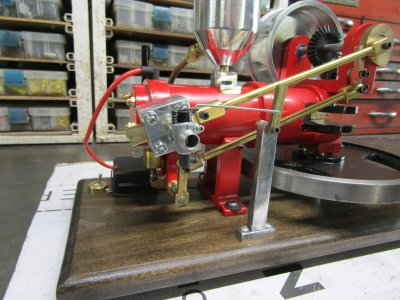-
Welcome back Guest! Did you know you can mentor other members here at H-M? If not, please check out our Relaunch of Hobby Machinist Mentoring Program!
You are using an out of date browser. It may not display this or other websites correctly.
You should upgrade or use an alternative browser.
You should upgrade or use an alternative browser.
Inspired Build of the Karl Benz 1886 Engine
- Thread starter rdean
- Start date
- Joined
- Feb 2, 2014
- Messages
- 1,068
Working on the fuel tank.
These are the bits that make up the tank.
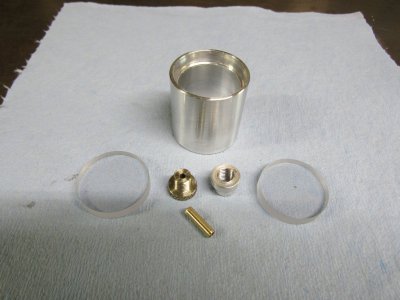
Installed view with an aluminum riser.
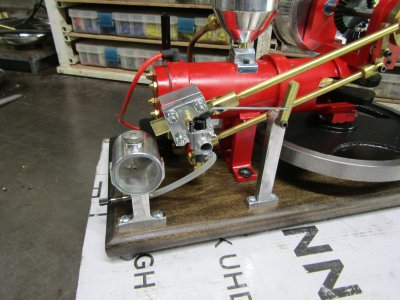
And from the front.
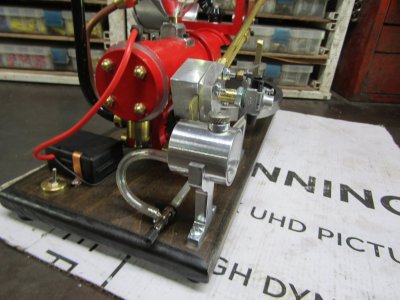
This carb uses a remote needle valve and the engine idle mixture is adjusted by varying the amount of bleed air instead of the amount of fuel supplied. This is the second carb of this type that I have used on my model engines and I still need to get more familiar with it's adjustments.
Thanks for looking
Ray
These are the bits that make up the tank.

Installed view with an aluminum riser.

And from the front.

This carb uses a remote needle valve and the engine idle mixture is adjusted by varying the amount of bleed air instead of the amount of fuel supplied. This is the second carb of this type that I have used on my model engines and I still need to get more familiar with it's adjustments.
Thanks for looking
Ray
- Joined
- Feb 2, 2014
- Messages
- 1,068
Thanks for the questions guys
The ends of the tank are plexiglass that are epoxied in to the aluminum barrel.
This is what we have been waiting for.
This short video shows the engine running at about 650 rpms but I would like it to be around 300. There are several things that need attention before I am satisfied with the build. The slide valve is one issue as I am losing about 25% of my power stroke around the valve. That also affects the intake stroke as it sucks some air in around the slide.
This build is not complete and I will post another video when I am happy with it.
Thanks for looking
Ray
The ends of the tank are plexiglass that are epoxied in to the aluminum barrel.
This is what we have been waiting for.
This short video shows the engine running at about 650 rpms but I would like it to be around 300. There are several things that need attention before I am satisfied with the build. The slide valve is one issue as I am losing about 25% of my power stroke around the valve. That also affects the intake stroke as it sucks some air in around the slide.
This build is not complete and I will post another video when I am happy with it.
Thanks for looking
Ray
- Joined
- Feb 2, 2014
- Messages
- 1,068
Worked on the slide valve some more today and came to the conclusion that it was always going to be a weak point of the engine. The use of springs, even stiff ones, to press the slide valve against the intake housing when the engine fires just isn't going to work. If the slide is lifted even a few thousands the power cycle and or the compression cycles are greatly reduced.
I tried using nylock nuts to achieve a preload on the slide with out any springs and as that did work as shown in the last post it was not something I was happy with.
This is my solution.
I cut a recess for an o-ring in the outer and inner plates for the slide to ride against sealing both sides of the slide at once. I used the nylock nuts but now I don't have to tighten them down as much which allows the slide move easier.
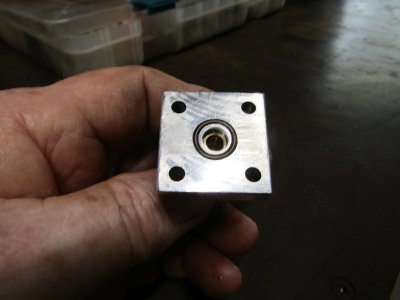
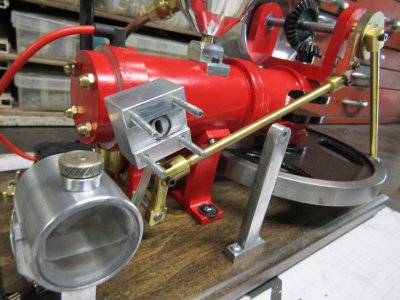
After a couple of test runs it seems to have solved the leaking problem.
When I test the engine now there is a noticeable difference in the output power so much so that I have to bolt it to the bench so it doesn't run away. It also starts much easier now.
I have a couple of other things I want to do to it and then a completed project video.
Thanks for looking
Ray
I tried using nylock nuts to achieve a preload on the slide with out any springs and as that did work as shown in the last post it was not something I was happy with.
This is my solution.
I cut a recess for an o-ring in the outer and inner plates for the slide to ride against sealing both sides of the slide at once. I used the nylock nuts but now I don't have to tighten them down as much which allows the slide move easier.


After a couple of test runs it seems to have solved the leaking problem.
When I test the engine now there is a noticeable difference in the output power so much so that I have to bolt it to the bench so it doesn't run away. It also starts much easier now.
I have a couple of other things I want to do to it and then a completed project video.
Thanks for looking
Ray
- Joined
- Sep 5, 2013
- Messages
- 3,207
I have to think that this was pretty much the same way the guys 100 years ago were coming up with their engines to begin with….. “hmm, this valve isn’t doing what I want so maybe if I did this it would give enough power to over here so that would go…”. Nice job Ray, you’re keeping the tradition alive and well! And in many ways, that really is the name of the game.
-frank
-frank
- Joined
- Mar 8, 2015
- Messages
- 309
Great job
- Joined
- Feb 2, 2014
- Messages
- 1,068
Frank that is very kind of you to say and I do enjoy figuring things out maybe more than building.
Thanks Chris
I made some changes to the engine, mainly cosmetic, and shot the final video.
1" piston
2" stroke
8" flywheel
water cooled
181 degrees highest recorded temp at cylinder head
156 degrees water temp in tank
roller bearing on the connecting rod
350 slowest rpm recorded
600 rpm is where the engine likes to idle
Over 2 thousand views
Thank you one and all for following along with likes and comments it does make a difference.
Ray
Thanks Chris
I made some changes to the engine, mainly cosmetic, and shot the final video.
1" piston
2" stroke
8" flywheel
water cooled
181 degrees highest recorded temp at cylinder head
156 degrees water temp in tank
roller bearing on the connecting rod
350 slowest rpm recorded
600 rpm is where the engine likes to idle
Over 2 thousand views
Thank you one and all for following along with likes and comments it does make a difference.
Ray
- Joined
- Mar 8, 2015
- Messages
- 309
Just purrs along


